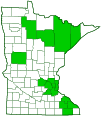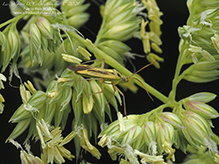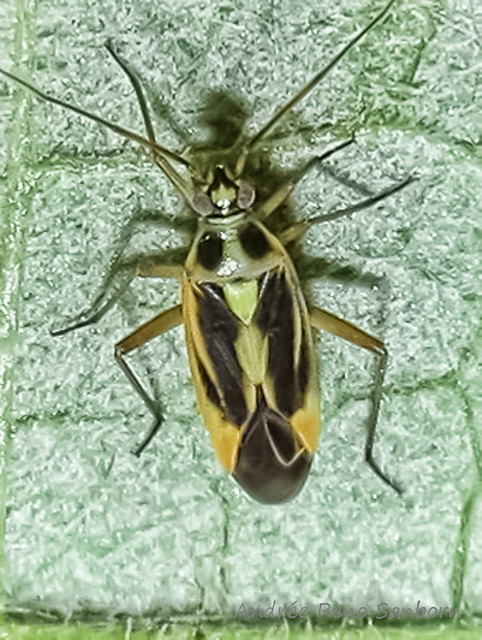two-spotted grass bug
(Stenotus binotatus)
Conservation • Description • Habitat • Ecology • Distribution • Taxonomy
|
|
||||||||||||||
Description |
Two-spotted grass bug is an exotic, soft-bodied, colorful, plant bug. It is small for a true bug (suborder Heteroptera) but fairly large for a plant bug (family Miridae). It is native to Europe and was introduced into North America, where it is now widespread. It is uncommon in Minnesota. It is considered a minor agricultural pest, attacking several cereal crops, especially wheat. The head is shorter than the first segment of the thorax (prothorax) and much shorter than the antennae. It is black in front and at the back, yellow or yellowish-green at the top. The light area at the top usually extends to the edges of the compound eyes and often extends in a narrow strip to the back of the head. There are two large compound eyes and no simple eyes (ocelli). The mouth parts take the form of a long, 4-segmented beak that projects downward and is optimized for piercing and sucking. The antennae are long and yellow tinged with black. The body is soft, ¼″ to 5 ⁄16″ long, elongated, and more or less parallel along the sides. The upper thoracic shield (pronotum) yellow at the sides and yellow or greenish-yellow on top. It has two large, elongated, oval spots that extend from near the front (anterior) margin to the rear (posterior) margin. There are two pairs of wings. They are held flat over the body when at rest. They are longer than and completely cover the body. The front wings (hemelytra) are longer than the hind wings. The front wings (hemelytra) are longer than the hind wings. The exoskeletal plate between the wing bases (scutellum) is large, triangular, bright yellow or greenish-yellow with no black markings. The hemelytra have a thickened, leathery part at the base and a thin membranous part at the tip with a clear dividing line between the two. The thickened part is comprised of the narrow area (clavus) behind the scutellum when the wings are closed and the broad marginal area (corium). At the end of the corium there is a small but distinct triangular area (cuneus). Each hemelytron has three oblique streaks, two black and the third blackish. The lower (distal) black streak extends toward the inner margin of the cuneus. As the insect ages, the black marks become darker and larger, merging into a single large black spot. The cuneus) is always yellow with no black markings. The membranous tip is black or blackish-brown with yellow veins. It has two closed cells. The hind wing is completely thin and membranous. The legs are long and delicate. The third (femur) and fourth (tibia) segment of each leg is yellow. The end part that corresponds to the foot (tarsus) is black and has three segments. The female is similar to the male but is greenish-yellow and has and the black markings are paler and much less extensive. |
Size |
Total length: ¼″ to 5 ⁄16″ |
Similar Species |
Habitat |
Fields, meadows |
Ecology |
Season |
Mid-June to mid-August |
Behavior |
|
Life Cycle |
|
Nymph Food |
Inflorescence of various grasses, especially timothy |
Adult Food |
Inflorescence of various grasses, especially timothy |
Distribution |
||
|
Sources |
|
| 6/17/2024 | ||
Occurrence |
||
|
||
Taxonomy |
|
Order |
Hemiptera (True bugs, Hoppers, Aphids, and Allies) |
Suborder |
Heteroptera (True Bugs) |
Infraorder |
Cimicomorpha |
Superfamily |
Miroidea |
Family |
|
Subfamily |
Mirinae |
Tribe |
Mirini |
Genus |
Stenotus |
Subordinate Taxa |
|
|
|
Synonyms |
|
Stenotus sareptanus |
|
Common Names |
|
slender crop mirid timothy plant bug two-spotted grass bug |
|
Glossary
Cuneus
The triangular, hardened, horn-like tip of the forewing of a plant bug (family Miridae).
Hemelytron
The forewing of true bugs (order Hemiptera), thickened at the base and membranous at the tip. Plural: hemelytra.
Femur
On insects and arachnids, the third, largest, most robust segment of the leg, coming immediately before the tibia. On humans, the thigh bone.
Ocellus
Simple eye; an eye with a single lens. Plural: ocelli.
Pronotum
The exoskeletal plate on the upper side of the first segment of the thorax of an insect.
Prothorax
The first (forward) segment of the thorax on an insect, bearing the first pair of legs but not wings.
Scutellum
The exoskeletal plate covering the rearward (posterior) part of the middle segment of the thorax in some insects. In Coleoptera, Hemiptera, and Homoptera, the dorsal, often triangular plate behind the pronotum and between the bases of the front wings. In Diptera, the exoskeletal plate between the abdomen and the thorax.
Tarsus
On insects, the last two to five subdivisions of the leg, attached to the tibia; the foot. On spiders, the last segment of the leg. Plural: tarsi.
Tibia
The fourth segment of an insect leg, after the femur and before the tarsus (foot). The fifth segment of a spider leg or palp. Plural: tibiae.
Visitor Photos |
||
Share your photo of this insect. |
||
This button not working for you? |
||
Alfredo Colon |
||
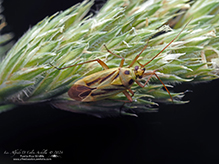 |
||
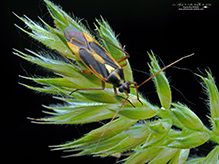 |
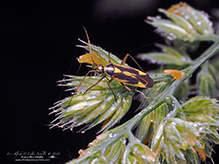 |
|
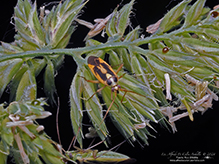 |
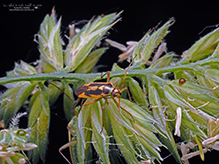 |
|
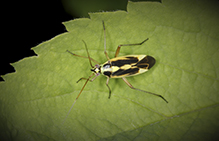 |
||
Mike Poeppe |
 |
Rene Blaeser |
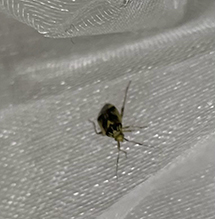 |
It was on my dahlia bloom |
MinnesotaSeasons.com Photos |
||
|
||
|
||

Visitor Videos |
||
Share your video of this insect. |
||
This button not working for you? |
||
|
Other Videos |
||
Wanze Stenotus binotatus Close up movies |
About
Published on Nov 29, 2012 Wanze Stenotus binotatus http://www.Tierportraet.ch |

Visitor Sightings |
||
Report a sighting of this insect. |
||
This button not working for you? |
||
Alfredo Colon |
Location: Albany, NY |
 |
Alfredo Colon |
Location: Albany, NY |
 |
Alfredo Colon |
Location: Albany, NY |
 |
Alfredo Colon |
Location: Albany, NY |
 |
Mike Poeppe |
Location: near Houston, MN |
 |
| Rene Blaeser 8/14/2022 |
Location: St. Michael, MN It was on my dahlia bloom |
 |
| Alfredo Colon 6/7/2021 |
Location: Woodbury, MN |
 |
| Alfredo Colon 6/14/2018 |
Location: Woodbury, MN |
 |
MinnesotaSeasons.com Sightings |
||
|

Created 10/26/2018 Last Updated: © MinnesotaSeasons.com. All rights reserved. |
